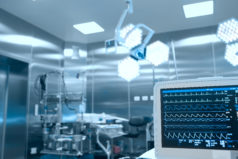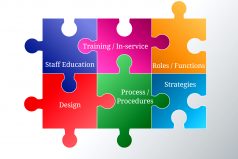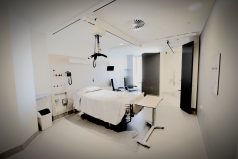Safe Patient Handling is a relatively newer clinical practice concept which demonstrates professional practice.
Designing and implementing a program like Safe Patient Handling and Mobility requires a strategic vision. The overarching intent of such a program is to replace traditional patient handling techniques through integrating patient-lift technology. Having this goal clearly established from the onset ensures that the program evolves in a purposeful direction. With vast experience spanning across different clinical cultures, I can promptly address the challenges that emerge during this transition.
The cornerstone of our comprehensive program design revolves around ceiling-lift technology. This choice is rooted in its ability to perform most patient care lifting tasks, its constant availability at the point-of-care, and the convenience it offers caregivers by eliminating the need of having to leave the patient’s room to retrieve a patient-lift device.
Many organizations grapple with the task of delineating the scope of such a comprehensive injury prevention program. Efforts to implement safer practice processes without a structured program framework often fall short of desired injury reduction outcomes. If we maintain the focus on the program’s core intent – to minimize risks related to manually lifting and moving patients by offering practical technology solutions – we increase the likelihood of consistent and sustained injury prevention.
Understanding the value of evidence-based injury prevention methods that accompany patient-lifts in clinical settings is fundamental to achieving decreased injury rates. My role with The RP Hawkins Group is to illuminate the intricacies of this process for injury prevention in hospital settings and to provide the necessary guidance through mentorship for effective utilization of patient-lift technology.
Through mentorship, I assist organizations by guiding a facility’s Safe Patient Handling Program Manager in implementing safer lifting practices for patient care. Our process rests on five fundamental mentoring principles. These principles understand that to consistently reduce employee injuries related to patient-lifting, the resources required to build efficient Safe Patient Handling programs must align with the clinical operating system that inadvertently produces patient-lift injuries. Our five principles are:
1 Establishing Safe Patient Handling as a clinical operations process
2 Developing the program lead as a consistent point of reference
3 Guiding the program lead to become efficient in Injury Risk Mitigation
4 Mentoring the lead to be the subject matter expert for Patient-Lift Equipment
5 Leading the injury prevention program through advocacy
We developed these principles to assist organizations in defining their Safe Patient Handling programs and the roles of the involved individuals. Our fundamental focus is to develop, implement, and sustain comprehensive Safe Patient Handling Programs tailored to our partners’ needs. The transition from dated lifting methodologies to a more modernized practice necessitates a comprehensive systems approach supporting these concepts for long-term sustainability. Our mentoring goal is continuous process development until a new patient-lift standard is achieved for our organizations.
If you’re considering establishing a new Safe Patient Handling Program or if your current program could benefit from a revamp, contact Roric to schedule a program assessment.





